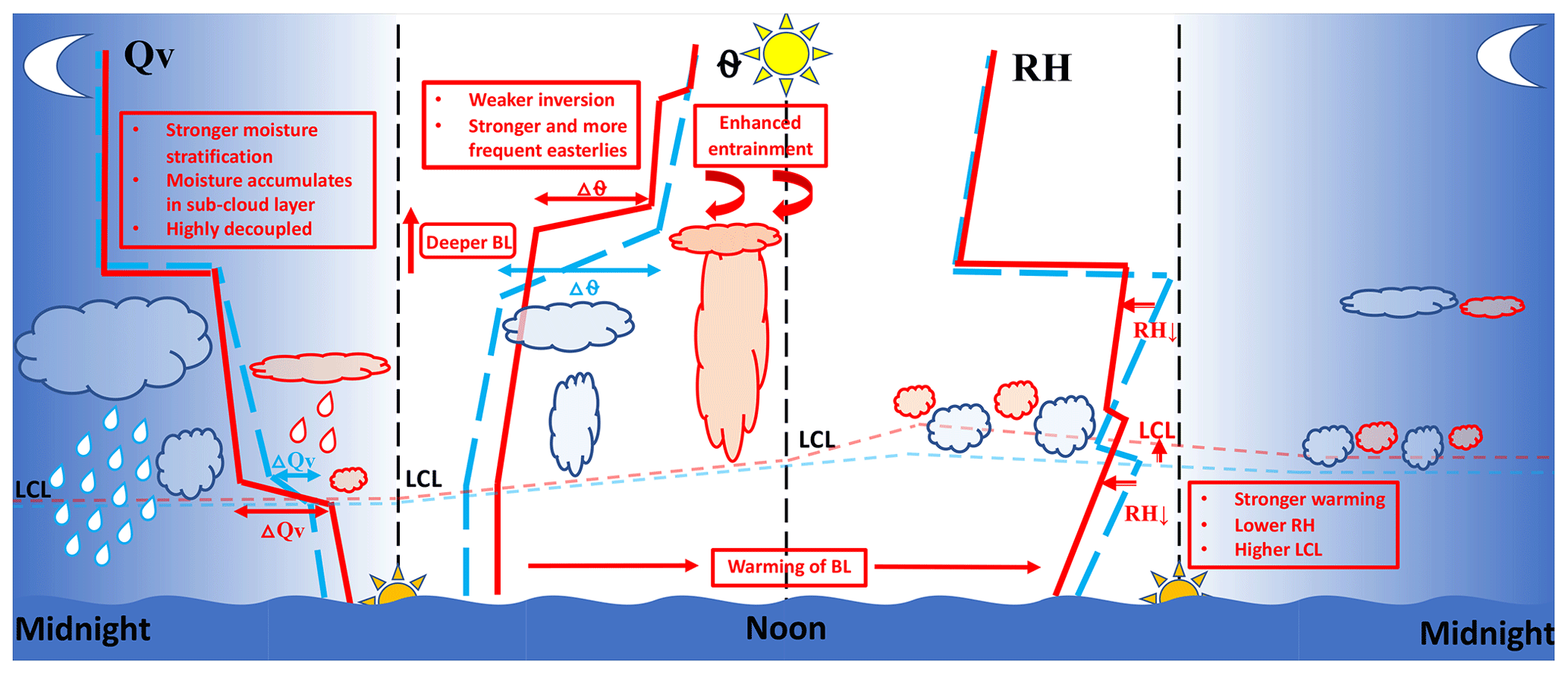The Impact of Biomass Burning Smoke on Clouds and Climate
Eastern subtropical oceans are home to warm and bright low-level stratocumulus cloud decks. Among them, the southeast Atlantic basin presents an unique opportunity to study smoke-cloud-radiation interactions where seasonally emitted biomass burning plumes from the southern African continent are being advected over the oceanic region via the southern African Easterly Jet. In this work, I investigated how the presence of biomass burning smoke affects marine boundary layer clouds, particularly in the remote southeast Atlantic region, using field data collected during the DOE LASIC (Layered Atlantic Smoke Interactions with Clouds) campaign.
The Science August is when the highest loading of black carbon is detected within the remote southeast Atlantic boundary layer. I find that the presence of sunlight-absorbing aerosols in the boundary layer suppress cloud water and coverage by modifying the boundary layer’s thermodynamic structure and coupling state throughout the diurnal cycle. In particular, the diurnal-mean liquid water path and low-cloud fraction are reduced when more smoke is present. Observations suggest a decoupling of the boundary layer that continues into the night, helping to trap moisture in the sub-cloud layer. After sunrise, the moisture can ventilate upwards, supporting more vigorous convection. The diurnal cycle is a useful model metric that can ultimately foster skill in simulations of the stratocumulus-to-cumulus transition and low-cloud behavior under future climate scenarios.

The smoke is primarily in the boundary layer in July-August; then, as the African continent warms, the September-October large-scale circulation encourages more aerosol transport in the free troposphere. Low cloud cover increases climatologically from July to October and becomes more stratiform. Despite similar seasonal cycles in sea surface temperature and large-scale circulation patterns, the monthly-mean southeast Atlantic low-cloud fraction increases more, compared to its counterpart of the southeast Pacific, during austral winter-spring.
I find that the combination of changing winds and aerosol transports helps reinforce the July–October evolution in low cloud cover and cloud morphology, compared to conditions with less aerosol present. Representations of the low-cloud seasonal cycle in climate models serve as an indicator of model realism, by comparing with that derived from observations that can then be used as an emergent constraint on the spread in the model equilibrium climate sensitivity (ECS).

The Impact These observationally based findings fill in the temporal dimension of aerosol `semi-direct’ effect and pose a challenging target for both process modeling and GCMs on their representation of aerosols, clouds, and their interactions with atmospheric circulations from diurnal to regional scales.
Related Publications
-
J. Zhang and P. Zuidema (2019): The diurnal cycle of the smoky marine boundary layer observed during August in the remote southeast Atlantic. Atmos. Chem. Phys., 19(23), 14493–14516. doi:10.5194/acp-19-14493-2019 (ACP highligh article)
-
J. Zhang and P. Zuidema (2021): Sunlight-absorbing aerosol amplifies the seasonal cycle in low-cloud fraction over the southeast Atlantic. Atmos. Chem. Phys., 21(14), 11179–11199. doi:10.5194/acp-21-11179-2021
-
P. Zuidema, A. Sedlacek III, C. Flynn, S. Springston et al. including J. Zhang (2018): The Ascension Island boundary layer in the remote southeast Atlantic is often smoky. Geophys. Res. Lett., 45(9), 4456–4465. doi:10.1002/2017GL076926
-
S. Abel, P. Barrett, P. Zuidema, J. Zhang et al. (2020): Open cells exhibit weaker entrainment of free-tropospheric biomass-burning aerosol into the south-east Atlantic boundary layer. Atmos. Chem. Phys., 20(7), 4059–4084. doi:10.5194/acp-20-4059-2020
-
P. Barrett, S. Abel, H. Coe, et al. including J. Zhang (2022): Intercomparison of airborne and surface-based measurements during the CLARIFY, ORACLES and LASIC field experiments. Atmos. Meas. Tech., 15(21), 6329–6371. doi:10.5194/amt-15-6329-2022
-
M. Diamond, P. Saide, P. Zuidema, et al. including J. Zhang (2022): Cloud adjustments from large-scale smoke–circulation interactions strongly modulate the southeastern Atlantic stratocumulus-to-cumulus transition. Atmos. Chem. Phys., 22(18), 12113–12151. doi:10.5194/acp-22-12113-2022 (ACP highligh article)
-
C. Howes, P. Saide, H. Coe, et al. including J. Zhang (2023): Biomass-burning smoke’s properties and its interactions with marine stratocumulus clouds in WRF-CAM5 and southeastern Atlantic field campaigns. Atmos. Chem. Phys., 23(21), 13911–13945. doi:10.5194/acp-23-13911-2023
Enjoy Reading This Article?
Here are some more articles you might like to read next: